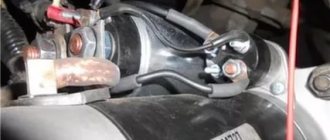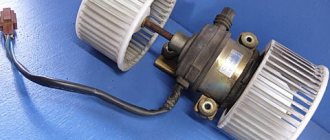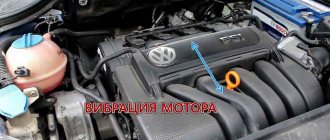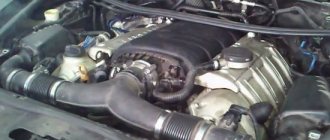This material will discuss the possible causes of white smoke from the exhaust pipe, which in most cases indicate the presence of malfunctions in the internal combustion engine systems. Normal combustion of the fuel-air mixture on a warm engine should occur without pronounced smoke, indicating the presence of foreign combustion products in the exhaust gases.
Author: Raul_ HF and wheel alignment mechanic; experience – 3 years. Service/repair consultant at Toyota DC; experience – 4 years.
White smoke when the engine is running properly
In conditions of high air humidity and in the cold season, condensation forms on the walls of the exhaust system circuit. When the engine is running, the muffler heats up, and moisture evaporates, mixes with the exhaust gases, and white smoke comes out of the pipe. This continues until all the condensation formed in the muffler has evaporated. To do this, it may not be enough to warm up the engine to operating temperature, and you may need to drive several tens of kilometers.
However, this is not smoke, but water vapor, and it quickly dissipates into the air. You may also notice drops of water at the end of the exhaust pipe. If the exhaust tract at the outlet is completely dry, and smoke from engine operation hangs like a cloud or fog, this indicates a problem and the need to diagnose the engine.
Kamaz Euro 2 smokes when cold
Kamaz smokes white smoke - Causes and consequences
The products of the Kama Automobile Plant, located in Naberezhnye Chelny, entered everyday life, became popular and distributed in forty countries. Mass popularity is the reason that the incorrect behavior of technology arouses consumer interest.
During operation of the power plant, a frequent occurrence is the abundant release of exhaust gases and the KamAZ smokes. For a working engine, this behavior is typical when starting, but it goes away after a short period of time. If not, the symptom indicates problems in the condition of the unit. The sooner the reason why the KamAZ smokes is identified and eliminated, the longer the engine will last.
Source
What can the exhaust color say?
Based on the color of the exhaust gases, we can draw conclusions about the following violations in the operation of the engine:
- black exhaust – a combustible mixture over-enriched in fuel;
- blue exhaust – oil entering the combustion chamber;
- white exhaust means coolant has entered the cylinders.
One of the reasons for black exhaust is a too rich fuel mixture. An excess of fuel enters the cylinders, and it does not have time to completely burn during the engine cycle. Unburnt fuel products are emitted through the exhaust pipe in the form of soot particles. The causes of the problem may lie in both the injection system and the ignition system.
Often, an over-enriched combustible mixture is the result of severe contamination of the air filter, which leads to a significant lack of air for combustion. Perhaps the malfunction is due to incorrect operation of the nozzles or injectors and is associated with ineffective atomization of the mixture or “overfilling” of fuel. Often black exhaust smoke is accompanied by unstable engine operation and loss of power.
The uncharacteristic bluish or white color of the exhaust gases indicates the presence in the cylinders of those components that ensure the functioning of the engine, but under normal conditions remain isolated and do not participate in the combustion processes of the fuel mixture. This becomes possible if the tightness of one of the engine circuits - oil or cooling - is broken.
When foreign liquid enters the engine cylinders, its combustion products also give the exhaust gases a corresponding color. For example, the loss of engine oil is accompanied by a blue exhaust, and thick white smoke from the chimney is the result of coolant entering the combustion chamber.
KamAZ smokes blue smoke reasons
When analyzing exhaust gases, attention is paid to the smell accompanying the exhaust. The indicator is especially important if the exhaust is blue.
The causes of blue smoke are:
- Uneven distribution of the fuel mixture by volume. With this phenomenon, blue exhaust is accompanied by a strong odor. The fact is that the diesel in the cylinder burns partially. The unused mixture is simply thrown into the pipe. Burnt fuel ignites on the surface of the piston and head, overheating the parts. Such a process, sooner or later, leads to damage to the pistons and melting of cylinder parts.
The reason for the phenomenon lies in faulty fuel equipment of the KamAZ diesel unit. Usually there is a problem with the fuel pump or injectors. Blue exhaust also appears at the initial stage of warming up the installation, here we are talking about the failure of the electric heating element, or a decrease in the seal in the chambers.
White exhaust on a gasoline car
White smoke from the exhaust pipe of a gasoline engine is a sign of the presence of a large amount of moisture in the combustion products. This can be observed even on a working engine in the following cases:
- in conditions of high air humidity, or in rainy weather;
- in winter, at temperatures below -10C, on a cold engine;
- at extremely low temperatures (below -25C) even with the engine warmed up to operating temperature.
The above reasons why white smoke comes from the exhaust pipe are explained by a simple temperature difference and increased vapor formation under certain weather conditions and air temperature. The exhaust is quite dense, but quickly dissolves, since it consists mostly of water vapor.
If the car is used for short trips, this phenomenon can be observed constantly, since all the moisture does not have time to evaporate completely during the short time the engine is running. You may even notice water flowing out of the exhaust pipe when accelerating or spray flying when the engine is running. It should be borne in mind that in this mode of operation of the car, the constant presence of water in the exhaust pipe will lead to its premature destruction by corrosion.
The formation of a dense white exhaust that hangs in the air for a long time at the exit of a warm engine is a sure sign that coolant, which is half water, has entered the combustion chamber. When the engine is running, the exhaust smoke becomes white, indicating that foreign components are burning together with the fuel. Its density is such that it resembles a smoke screen and completely blocks visibility.
White smoke from the exhaust pipe of a gasoline engine - the main causes
A car is a complex mechanism, its malfunctions manifest themselves in various symptoms. Sometimes car owners do not pay much attention to the exhaust, although it can signal serious problems. Regular maintenance and prevention help extend the service life of various car systems, but troubles still happen. The consistency and color of the exhaust are markers that can indicate significant damage.
If you get rid of the problem in time, there is a high probability of avoiding expensive repairs.
Find out the cost of diagnosing a gasoline engine online in 3 minutes
Don't waste your time - use the Uremont search and get offers from nearby services with specific prices!
Diagnostic methods for the appearance of white exhaust
If it is determined that the white smoke is not caused by natural evaporation of condensation in the exhaust system, you should check and confirm the presence of a malfunction by checking the following:
- pull out the dipstick and look at the color and condition of the engine oil;
- check the engine coolant level;
- check for traces of oil in the coolant;
- check the cooling circuit for exhaust gases entering it;
- check the change in pressure in the cooling circuit when starting the internal combustion engine;
- Check the cleanliness of the spark plugs (on a gasoline engine).
When coolant and oil are mixed, an oil-water emulsion is formed, which is very different from normal oil in both color and consistency. You can accurately determine that there is clearly something wrong with the lubricating fluid by visual inspection - simply by pulling out the dipstick.
If there is a consumption of coolant, then its level in the radiator and expansion tank should decrease. A significant decrease in the amount of fluid in the system in the absence of external leaks speaks volumes about the presence of leaks inside the engine. At the same time, you need to pay attention to the condition of the coolant: if oil stains are visible, it means oil is leaking into the system from the adjacent lubrication circuit.
If there is a possibility of coolant getting into the cylinders, then exhaust gases will also break through into the cooling circuit along the same path. To check, squeeze the upper radiator hose and start the engine. If you feel with your hand that the pipe has “inflated” when the internal combustion engine starts, it means that gases from the combustion chamber are breaking into the circuit and the pressure in the cooling system increases.
On a gasoline engine, it is additionally worth unscrewing the spark plugs and inspecting their condition. If there is moisture in the cylinders, the working part together with the electrode will stand out as clean, as if it had just been washed. Although under natural conditions everything there should be covered with black soot.
How it works and why the smoke turns white
A diesel engine implements the principle of igniting a mixture of diesel fuel and air from compression, even if there are spark plugs, they are needed only to facilitate starting; they do not participate in igniting the mixture when the engine has entered the mode. The sprayed diesel fuel is mixed with air and sharply, under high pressure, compressed, as a result of which the mixture heats up and spontaneously ignites.
In a working engine, air and fuel are supplied at the right time and in the right proportions, resulting in complete combustion of the mixture after self-ignition, after which gases are released through the exhaust manifold and muffler. Burnt gases have practically no color, and if the exhaust turns white, this means:
- It is possible that coolant (coolant) is getting into the cylinders,
- Incomplete combustion of fuel inside the cylinders,
- Increased humidity when the exhaust system warms up,
- Condensation accumulated inside the exhaust system.
When a diesel engine warms up (it first runs cold), the appearance of white smoke is absolutely normal. What makes it white is the steam formed in the exhaust system from condensate. Condensation appears if the car has been left outside overnight. When warming up, the muffler heats up and the condensate evaporates. After warming up (a few minutes after starting the engine), the steam disappears.
In winter, this happens longer, since condensation evaporates less quickly and the engine takes longer to heat up. The lower the temperature, the longer the vaporization will take. In addition, diesel fuel does not burn completely due to untimely ignition of the mixture inside the cylinders. Its presence in the exhaust gas also gives a white color.
If the gases become transparent as the engine heats up, your car is in order, there are no malfunctions, there is no need to worry.
When the diesel engine has warmed up (running hot), the appearance of white exhaust means that the combustion of the fuel inside the cylinders is delayed due to a disruption in the fuel supply through the injectors. Possible reasons:
- Increased pressure in the injectors - fuel injection pump malfunction.
- The plungers inside the injection pump may have worn out.
- The injection cycle is disrupted - the fuel injection pump is incorrectly configured and requires adjustment.
- One or more injectors are malfunctioning; they create an overflow.
- Compression inside one or more cylinders is reduced, valves are missing or rings are stuck.
Simultaneously with such malfunctions, the diesel engine has problems starting, it starts up poorly and begins to “triple”, instability of operation is felt both at minimum idle speed and under load. Power when driving is noticeably reduced, and diesel fuel consumption increases noticeably.
Another reason for heavy smoking may be engine cooling liquid entering the cylinders. Whiteness and intensity are caused by its evaporation during diesel operation. Depending on the properties and color of the liquid, the exhaust becomes grayish or even bluish.
This is the most dangerous problem for the motor. During the combustion of diesel fuel mixed with water, sulfur oxide and sulfur dioxide are formed, which destroys the engine itself and all associated systems.
Possible causes of leakage of internal combustion engine circuits
The reasons for fluid entering from one independent circuit into another are usually associated with a violation of the integrity of the cylinder head gasket. The gasket has many holes with seals for the oil and coolant channels. It is most often subject to deformation and destruction as a result of engine overheating. As a result, the gasket cracks or the seal wears out, resulting in leaks. In particularly difficult cases, a crack may occur on the cylinder block body itself.
The coolant enters the combustion chamber. Its remains, which do not have time to evaporate and fly out into the chimney as white smoke, flow down the cylinder walls into the crankcase, diluting the oil. In addition to the above options for water getting into the oil, it is necessary to check all other possible causes.
Also, when diagnosing, it is recommended to pay attention to factors that could cause a significant increase in engine temperature. For example, incorrect operation of the thermostat, which also needs to be replaced along with the cylinder head gasket. Finding the cause of the malfunction will most likely require engine disassembly, as well as qualified specialists who have sufficient experience and knowledge to perform the task efficiently.
Why does colored (for example, white) smoke come from the exhaust pipe?
Color in this case speaks volumes. For example, blue (from blue to dark shade) means that oil has entered the engine cylinder. This process is often accompanied by increased fuel consumption. Often blue color indicates failure of the elements of the cylindrical and piston groups. When diagnosing, it is important to inspect the areas in direct contact with the cylinder. In addition, you need to check the side surfaces and recesses of the piston rings. The problem here arises due to sealing of the gaps, which is caused by the excessive volume of oil entering the system. Minor contamination does not cause a visible compression failure, but it is necessary to check this possibility when thick blue exhaust appears. A white-blue tint in combination with excessive fuel consumption can also be a sign of a valve seal failure and an ignition malfunction. New cars “smoke the air” in the same way, but the smoke gradually dissipates (in this case there is no reason to worry).
The black version indicates potential breakdowns:
The “charcoal” tint appears due to excessive concentration of fuel in the fuel-air mixture.
As a result, the fuel does not burn through completely, which makes the exhaust toxic.
The most common cause is a malfunction of the fuel supply or ignition system. A gray-black color indicates a carburetor malfunction. The reason is that the float chamber overfills due to clogged jets or faulty needle parts. In this case, you need to clean the camera. If this does not help, replace the parts using a repair kit.
Dense white exhaust smoke - a serious malfunction with consequences
Oil diluted with coolant turns into a white emulsion, completely losing its working properties and qualities. Such a lubricating fluid is no longer able to effectively perform its functions and will inevitably lead to increased wear of the components of the power unit, up to its complete failure.
Therefore, the causes of white smoke from the exhaust pipe must be diagnosed and measures taken to eliminate them as quickly as possible, and the operation of the car should be suspended in order to avoid major problems with the engine.
Why does white smoke come from the diesel exhaust pipe?
There is no need to worry until the internal combustion engine has warmed up. But such smoking on a hot engine is a cause for concern. Possible reasons are listed below:
- there is condensation in the solarium;
- diesel fuel does not burn completely;
- the injectors do not work correctly and the fuel overflows;
- reduced compression.
If the system uses a particulate filter (for example, DPF), smoke may also appear when the soot burns - this is normal for diesel units.
Procedure
To initially verify that there is a problem, you need to accurately determine the color and shade of the exhaust (at the outlet from the muffler), look at the level of the coolant mixture and rule out leaks.
If leaks are detected in the cylinders, experienced motorists recommend not to operate the car, but to immediately solve the problem. Otherwise, there is a high probability of a rapid decrease in the properties of the lubricant, which interferes with antifreeze.
Source
How to check why white smoke appears?
Gas of this color can come out of the muffler for various reasons, so before starting any repairs, you should accurately determine its cause. You need to start by checking the amount of oil remaining. Pay attention to the color of the liquid to see if an emulsion has appeared. There should be no water in the lubricant; this is extremely harmful to the engine. If liquid is present, the exhaust will not just become white, but will take on a bluish tone. Its distinctive feature is that it does not dissipate at all, but looks like a foggy cloud behind the car.
Remove the coolant expansion tank cap and see if there is any sediment there. Often a thick film appears there. If you hear a foreign smell, then this is also a bad sign indicating the presence of moisture in the engine. After unscrewing the spark plug, pay attention to whether it has turned black: if there is carbon deposits, it means that the fuel does not burn completely. The car may not start well, again it is worth checking the spark plugs; if they are dirty with oil particles or wet, then there is a malfunction in the engine.
Paper check
If you have a white napkin or paper sheet, you can do the following test: bring it to the exhaust pipe and hold it for a few seconds, without pressing it close. If there is moisture in the system, the surface will remain white. If there are foreign impurities, its color will change. For example, if there are oily components, greasy stains will remain on the paper; the cooler will turn them blue or yellow, with a pronounced unpleasant aroma.
Check the condition of the gasket and cylinder block. If there are cracks, water gets in through them. Particular attention should be paid to the surface of the cylinder head. Inspect the inside of the cylinder, the place where the valves are located. Sometimes cracks are not visible visually; for this, a pressure test is performed. However, this must be done with caution; if the block is significantly damaged, a water hammer will occur due to the accumulation of liquid above the pistons.
Emulsion on the lid
The smell of exhaust is not always audible in the radiator part; the pressure may remain normal, but coolant enters the engine. You can easily find out about this: white smoke, low fluid level, emulsion traces under the cap of the expansion tank. The coolant enters the engine through the intake system.
You will have to look at the condition of the intake manifold; for this it is not necessary to remove the cylinder head. The causes must be eliminated, otherwise significant damage will be caused to the motor, ranging from problems with constant overheating to more complex breakdowns.
What is the difference between white exhaust and steam?
When the temperature in the atmosphere drops, clouds of white smoke pour out of the car's exhaust system. In winter this is not a cause for concern, but in the summer season, thick white smoke is a warning factor. This applies to all vehicles, regardless of what type of power unit is installed: gasoline or diesel.
Harmless steam does not have an unpleasant characteristic odor. It is formed by the evaporation of condensate, which concentrates on the exhaust system pipes when the temperature drops below plus 10°C.
White smoke coming out of the muffler, unlike steam, indicates problems in the engine. To more accurately determine the location and severity of the defect, it is necessary to study the shade, smell of the exhaust, and analyze changes in the behavior of the vehicle. Most often, this symptom occurs under the influence of the following factors:
- Presence of moisture in the engine.
- Water in gasoline.
- Violation of injection adjustments.
- Poor combustion of fuel mixtures.
- Coolant leaking into the cylinders.
Common reasons
For professionals, determining the cause of white smoke from gasoline or diesel cars is not a problem.
In this case, there is no need for diagnostic equipment or other equipment.
Let's look at where white smoke comes from and whether you should panic.
There are several reasons.
1. Evaporation of condensate.
If, while warming up the car or during acceleration, you notice the release of a “cloud” of white smoke, then you should not think about the worst. In winter, this symptom is a common occurrence.
After the last trip, water condensation accumulates in the resonator and catalyst. As soon as the engine starts, it boils, which leads to the appearance of steam that comes out along with the exhaust gases.
After 15-20 minutes (after the engine warms up), the white smoke becomes transparent. A similar phenomenon can be found not only in winter, but also in late autumn, when the temperature is close to zero.
It is important to distinguish blue smoke from white vapor. The latter tends to quickly dissolve in the air after leaving the pipe.
As for oily smoke, it forms a continuous fog around the car.
This symptom indicates combustion of oil in the engine and increased wear of the piston group elements.
One way out in this case is to install new valve stem seals.
2. Antifreeze gets into the manifold.
If it’s warm outside, but white smoke still pours out of the exhaust pipe, then we can talk about problems directly with the power unit.
As a rule, this symptom indicates that coolant has gotten into the oil.
During combustion, antifreeze forms a white “cloud”. Please note that the color largely depends on the type and type of coolant and its brand.
To verify the real reason for the appearance of white smoke, it is worth conducting a small experiment.
Get out of the car and hold a clean white sheet to the exhaust pipe outlet. If greasy drops are visible on it, then you can be sure that antifreeze has entered the system.
In a situation where no traces remain, the cause of the white smoke is water.
Subsequent diagnostics are carried out in several stages:
- unscrew the plug from the expansion tank;
- start the engine;
- carefully inspect the surface of the liquid for the appearance of oily stains on it;
- take a sniff. The smell of exhaust from the reservoir indicates that coolant has entered the system.
Why does the 405 gazelle engine smoke?
Gazelle Sable.
The engine smokes By the color of the exhaust, you can more accurately diagnose a breakdown, as well as identify the severity of the problem at various stages. In certain cases, the appearance of smoke is accompanied by:
-difficulty starting a cold engine; -unstable operation of the engine at idle and under load; - the revolutions on the tachometer may fluctuate; -increased consumption of fuel and engine oil is observed; -the engine loses power, etc.
There are also situations where smoking from a cold or hot engine is the only sign of a malfunction in the power unit.
Causes of engine smoking
The list of main faults that cause increased smoke formation includes:
- problems with the fuel supply system; - wear of the cylinder-piston group; - malfunctions of the gas distribution mechanism; - malfunctions of the engine cooling system;
The appearance of smoke can be caused by incomplete combustion of the fuel-air mixture, failures in the combustion process, or the ingress of coolant from the cooling system or engine oil from the lubrication system into the combustion chamber. These faults can color the exhaust gases a certain color.
Additionally, it is worth considering that problems with one system can lead to the malfunction of other components and elements. As an example, consider the ineffective operation of the engine cooling system. Insufficient cooling leads to engine overheating and destruction of the piston rings. Problems with the rings mean that oil starts getting into the cylinders and the engine smokes.
Its occurrence is primarily associated with the formation of condensation. Often the engine smokes white smoke when cold. If this phenomenon occurs in winter or with high humidity, then the owner should not worry - this is the release of steam formed during heating. The reason for the appearance of such smoke on a warm engine may be antifreeze getting inside the block. But there is a characteristic sign - a specific smell of smoke, which cannot be confused with anything, very unpleasant. The penetration of antifreeze into the cylinders disrupts work processes and leads to impaired cleanliness of the cylinder surface and increased wear of the main parts. Such a defect cannot be ignored!
White smoke is a vapor that easily dissipates into the air. To check, you can attach a sheet of clean paper to the exhaust pipe. The water will gradually dry on the sheet without leaving any distinct greasy marks.
The next step in diagnosis is to check the cooling system for exhaust gases. To do this, simply unscrew the radiator cap or expansion tank cap with the engine off. If you smell the exhaust, there is a film of oil in the fluid itself and the fluid level is low, then the malfunction is obvious. Starting the engine in this case will lead to a significant increase in pressure and an increase in the coolant level in the tank. You can also observe gas bubbles and even seething in the tank.
Subsequent stopping of the engine will cause the level to drop and the coolant will partially flow into the cylinder. From the cylinder, the liquid seeps through the piston rings and ends up in the oil pan, mixing with the lubricant and diluting the engine oil. It turns out a kind of emulsion, the color of the oil changes and the lubricant becomes cloudy.
The entry of coolant into the lubrication system is diagnosed by analyzing the cylinder head cover and the oil filler plug. A light foam appears on the inside of the lid, which has a yellowish tint. The presence of emulsion in the oil can also be seen on the oil dipstick. A large amount of coolant in the lubrication system will indicate a serious crack or burnout. In some cases, liquid may accumulate in the space above the piston, making it difficult to start the engine. It is worth adding separately that in such a situation there is also a high risk of water hammer. With minor coolant leaks, an emulsion may be present on the cap, but other signs will not be immediately noticeable.
Fault diagnosis
You can more accurately determine the problem cylinder in the following ways:
-Unscrew the spark plugs and check their condition. Coolant tends to “wash out” the spark plug in a faulty cylinder. -Align the crankshaft so that the intake and exhaust valves are closed. Next, you need to apply compressed air through the spark plug hole, and then look into the expansion tank. An increase in coolant level as a result of air supply will directly indicate a faulty cylinder. -Remove the cylinder head to check the gasket and the adjacent surface of the head. If no defects are identified, then the head is checked for tightness under pressure; - Carry out diagnostics of the cylinder. To do this, the piston must be lowered to BDC and the walls checked for cracks; -Check the intake manifold gasket. This is done if, in a particular internal combustion engine, such a gasket structurally serves to seal the coolant circulation channels.
Black smoke from the exhaust pipe
Its appearance is associated with an enriched fuel-air mixture, i.e. the amount of gasoline exceeds the calculated amount. This leads to gasoline washing away the oil from the cylinder walls and, as a result, failure of the cylinder-piston pair. Engine water hammer may also occur. The main companion of black exhaust is increased gasoline consumption. The reason that the engine smokes may be a malfunction of the fuel supply, ignition or injection control systems.











